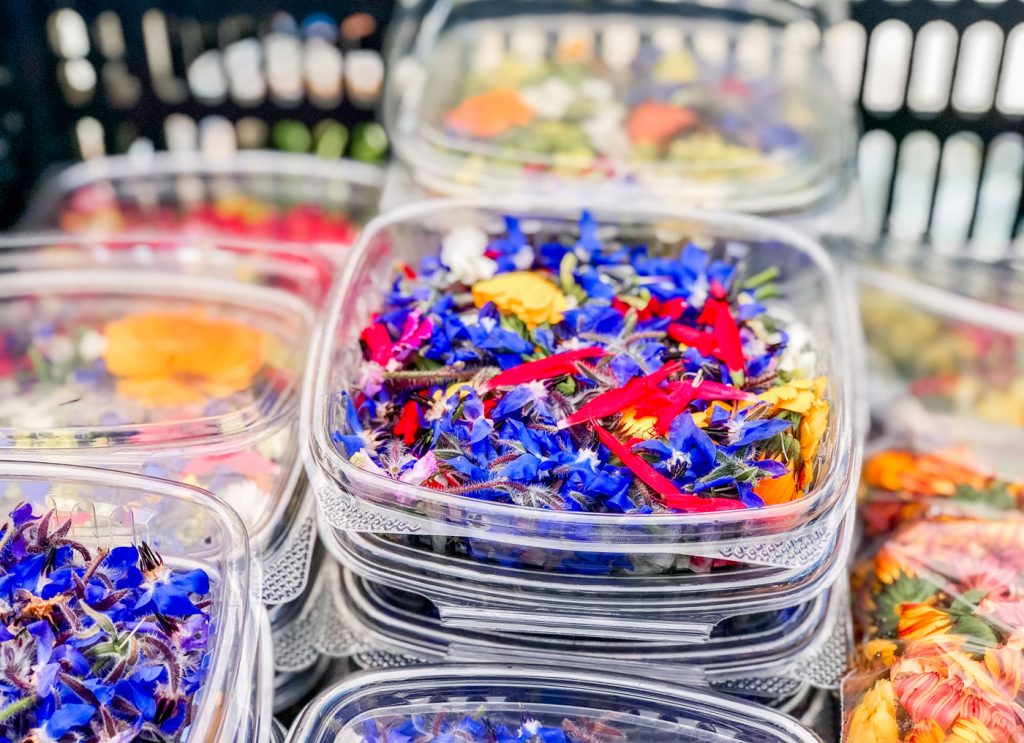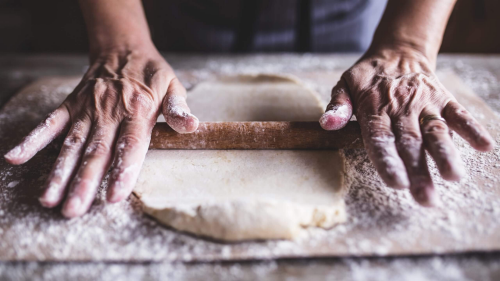
Mustard flowers line the roads on the drive through California’s Napa Valley, their bright yellow blossoms painting the landscape with a brilliant burst of edible sunshine. It’s a stunning display of nature, but it’s only the beginning of what’s in store. That’s because we’re heading to the property of Peter Jacobsen, farmer to some of the region’s top culinary stars, and a purveyor of edible flowers. Jacobsen’s acre-and-a-third-sized farm sits down a short dirt driveway in Yountville, California, the same Wine Country town that houses The French Laundry. This legendary Michelin 3-star restaurant also happens to be Jacobsen’s top customer.
Once on site, we find ourselves among a sea of more mustard flowers and dozens of fruit trees, including peaches, plums, and almonds (a stone fruit) that are just starting to blossom. Closer to the ground, there’s a bit of edible everything: seemingly obscure plants like cardoon, “the grandmother of artichoke,” as Jacobsen calls it; the sweet and earthy tasting Veronica cauliflower (aka broccoflower); and even marjoram, an aromatic herb that looks like oregano, but isn’t.
The thing about these trees and plants: they all flower. Not at once, Jacobsen assures us, but the farm has about 25 different kinds of edible flowers that blossom here throughout the year. “It’s a little culinary dreamworks,” he says, but this garden of delights is seemingly non-consumable to the untrained eye. Thankfully, that’s all about to change.


EDIBLE FLOWERS THROUGH TIME
The ancient Greeks loved to sprinkle calendula petals onto their mixed greens before eating, the ancient Romans flavored sauces with lavender blooms, and in India, bowls of curry fragranced with the sweet aroma of banana florets often went hand-in-hand. In fact, edible flowers have been a large part of culinary gastronomy as far back as BCE.
They elevate plates, enliven beverages (like the glasses of rose-petal water served at Renaissance-era plays), and sometimes even infuse oils. Edible flowers are the coveted delights of Bib Gourmand and Michelin starred chefs everywhere, including the French Laundry’s own Thomas Keller. These days they’re also increasingly popular among home cooks, who are adding them to stir-frys, floating their petals onto salads, and brightening up cheese plates and charcuterie boards with varietals like chrysanthemums and marigolds.
Now in its sixth-year, Little Wild Things City Farm in Washington D.C. sells edible flowers to restaurants, bars, and private caterers, as well as home chefs in the greater D.C. area. “Our sales used to be ninety-percent restaurants,” says founder Mary Ackley, “but once the pandemic hit, there was a precipitous drop.” So they shifted their focus to residential deliveries instead. The result is Salad Share, a subscription-based program that includes 10 weeks of microgreens and edible flowers delivered fresh to area customers. “Salad Share really allows us to be creative,” Ackley says. “Now we can choose the flowers we grow, and the combinations of our harvest to send.”
Along with farmers markets and specialty grocery stores like Whole Foods and Trader Joes, programs like Salad Share also make edible flowers more accessible to everyday consumers. Although most home cooks won’t have the time or disposal income to whip up pansy-topped shortbread cookies on a regular basis, adding a pinch of zinnia petals to chicken tacos once-a-month is an effortless and achievable goal.


WHAT MAKES THEM EDIBLE
“The definition of an edible flower,” Jacobsen says, handing me a tiny white chickweed blossom to taste, “is that it won’t kill you if you eat it.”
After that, how a flower looks, tastes, smells, or can be utilized in cooking, baking, plating, or other culinary endeavors depends on the flower itself.
Take bachelor’s buttons (aka cornflowers), a range of intensely colored blooms that grow in stunning shades of blue, pink, purple, and white. “They’re gorgeous,” says Ackley, “and can be used in so many ways.” You can dry up their petals and use them to brighten loose tea blends, boil them with sugar to make a syrup for martinis, or mix them with the corolla of other edible flowers like zinnias, dianthus (aka carnations), and dahlias, resulting in a rainbow of edible flower confetti.
But edible flowers aren’t limited to your traditional floral blooms. There are also the flowers sprouting from herb plants like cilantro, basil, chamomile, and borage—a small, brilliant blue blossom that produces a delicious cucumber-like flavor (and one that bees love). Then come the ones from brassica plants, including mustard, turnips, and radish, as well from other seasonal cover crops such as peas and fava beans. “In the legume family, especially, the flowers reflect the taste of the vegetable,” says Moira Kuhn, who—along with her husband, Jesse—runs Marin Roots Farm in Marin County, California. For instance, she says, pea flowers have a hint of the earthiness that you’ll get from peas, “though it’s a more subtle taste,” says Kuhn, “in part because of the pollen.”



HOW TO USE EDIBLE FLOWERS
Whether it’s decorating cakes and desserts with crystalized apple blossoms, sauteing up zucchini blossoms with garlic and olive oil, or even dropping a few edible flower-filled ice cubes into your favorite beverage—like a refreshing glass of ice water filled with cubes of basil flowers and slices of fresh cucumber—the uses for edible flowers are endless.
“What’s really fun about edible flowers,” says Jacobsen, “is the ability to look at this, or to smell that, and say, ‘what can I do with it?’ Most flowers can be used in one way or another.”
Take the vibrant hues and delicate flavors of orange marmalade, lemon meringue, and blackberry sorbet violas, which make excellent candied flowers. Or try deep-frying dandelions, garnishing a pizza with mustard blossoms, or floating the petals of citrusy marigolds onto the tops of cupcakes.
While orange blossoms are subtle in taste, they have an intense aroma that can be infused into sugar, and then added to iced tea—creating an almost perfumy flavor. San Francisco chef Matthew Accarrino, whom Jacobsen has been working with for years, is a big proponent of using the fragrant and lipped flowers of bell beans (small-seeded fava beans) in Caesar salads at his Michelin-starred restaurant, SPQR. “They add a flavorful umami taste that Matthew finds similar to anchovies,” says Jacobsen.
Marin Roots Farm is a regular purveyor at San Francisco’s Saturday Ferry Plaza Farmers’ Market, where customers swing by for their weekly fix of organic produce and edible flowers like calendula, which has easy-to-pull-apart bright orange or yellow blossoms—the petals of which make great edible confetti. They also taste similar to saffron, and are sometimes used as a flavor substitute in yellow rice and pastas. Another customer favorite is nasturtium, which has an almost peppery flavor. It can also heighten most any dish with its dazzling array of colors. “They’re really pretty on the plate,” says Jacobsen, “But I also know chefs who have used their spiciness to infuse honeys, syrups, and oils. It’s all about being imaginative.”
For instance, rosemary flowers have a light rosemary taste, but their foundations (which are easy to remove) are much more intense. “Whether you pull them apart or leave them intact depends on how much flavor you want,” Jacobsen says. Ask yourself questions like, ‘am I using rosemary’s tiny blossoms to decorate sushi, or to give my grilled pork a bit of a piney, pungent bite?’
“With edible flowers,” says Ackley, “the sky’s the limit in terms of creativity.”
“What’s really fun about edible flowers,” says Jacobsen, “is the ability to look at this, or to smell that, and say, 'what can I do with it?”


SHOPPING FOR EDIBLE FLOWERS
Edible flowers are easy to find at farmers’ markets, online sites like Gourmet Sweet Botanicals and Marx Foods, and the produce section of many grocery stores and supermarkets.
Try to use them as soon as possible after harvest, since the bulk of edible flowers will start wilting in a day or two. For a longer shelf-life (four-to-five days), keep them moist and refrigerated in an airtight container.
Marin Roots Farms is a big proponent of clamshells, airtight containers of varying sizes that they fill and sell with a variety of edible flower types. Not only are these clear, plastic containers easily storable, but “When you purchase a clamshell,” Kuhn says, “you can pick and choose the flowers you want to use for each meal.”
Another trick for lengthening the shelf-life of edible flowers is to freeze them in ice cubes (nasturtiums, pansies, borage and herb blossoms like lavender and basil are some of the ones that work best for this), and then pop them into your drinks later in the week. If you try and freeze edible flowers on their own, they’ll quickly lose their sheen after thawing.
When you’re shopping for edible flowers, really think about how you’ll be using them. Some, such as pansy blossoms and fresh basil blossoms, are obvious showstoppers on a plate, but if it’s flavor and scent you’re after, consider something like peach blossoms, which have a light aroma and a surprisingly almond-like taste.


GROWING YOUR OWN
For your own home garden, Jacobsen suggests starting off with hardy varietals, like bachelor’s buttons and borage. Calendulas and johnny jump ups are also easy growers.
While any size garden will do, the bigger the space, the more variety. “It’s really about the experience of learning new things as you go,” says Jacobsen. “There’s also the fact that edible flowers make everything look, and feel, much more special.”
Related Articles
-
 Food & Drink March 16, 2020 | 5 min read Going Rogue in the Kitchen Eventually, I did what most people do when they’re feeling confident in the kitchen. I whipped up a pot of homemade soup without any instructions.
Food & Drink March 16, 2020 | 5 min read Going Rogue in the Kitchen Eventually, I did what most people do when they’re feeling confident in the kitchen. I whipped up a pot of homemade soup without any instructions. -
 Food & Drink March 16, 2020 | 6 min read Delicious Differences: Potatoes Mashed potatoes. Fried potatoes. Hash browns. Baked potatoes. The list goes on for all the ways you can prepare potatoes in the kitchen.
Food & Drink March 16, 2020 | 6 min read Delicious Differences: Potatoes Mashed potatoes. Fried potatoes. Hash browns. Baked potatoes. The list goes on for all the ways you can prepare potatoes in the kitchen. -
 Food & Drink June 11, 2020 | 6 min read Food Traditions Family traditions don’t always have rhyme or reason, but they give us something to look forward to, and remind us to be grateful.
Food & Drink June 11, 2020 | 6 min read Food Traditions Family traditions don’t always have rhyme or reason, but they give us something to look forward to, and remind us to be grateful.
